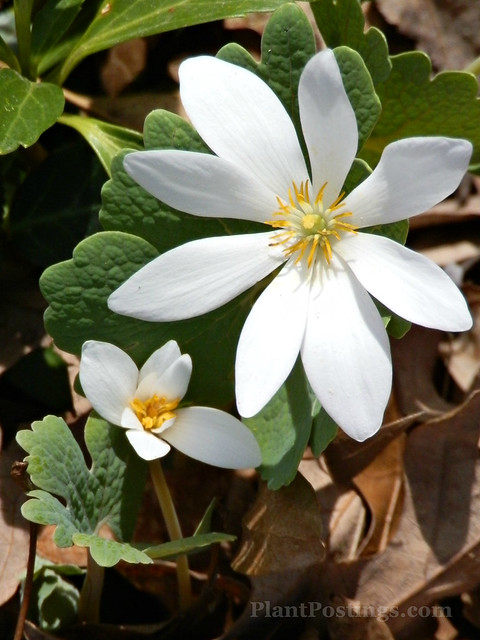
"Every woodland garden needs Bloodroot." Try Googling that sentence and you'll see how many people recommend this magical ephemeral that pokes its way through the forest floor for a brief moment in time in early spring.
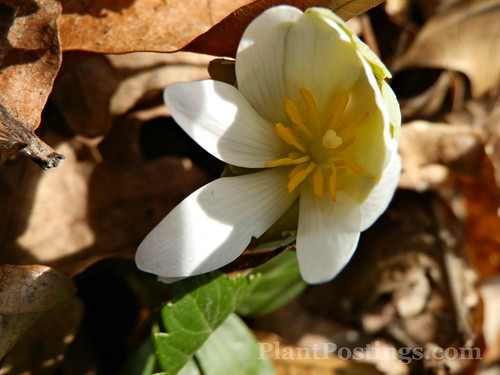
While it isn't blooming in my garden yet, Bloodroot (Sanguinaria canadensis) is one of the first plants to emerge in spring. It blooms quickly, as the spring sun warms the soil, but before deciduous trees add their leaves. You're likely to miss it if you aren't watching for it, because the blooms only last for one to three days.
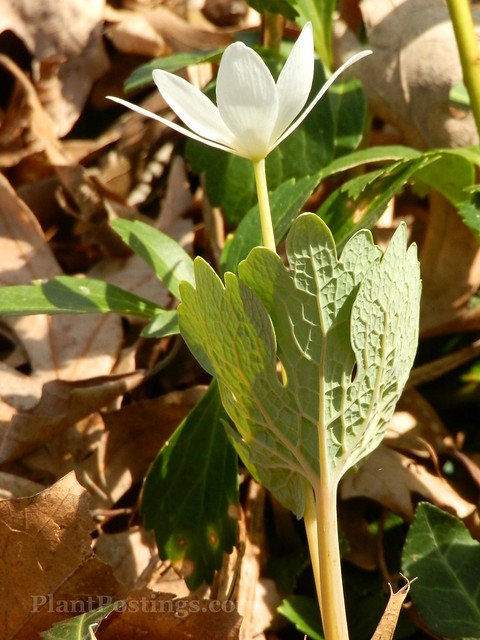
One of the best descriptions of the "how" and "why" of Bloodroot's growth and pollination is in this article at Native Plants and Wildlife Gardens. No other plant is quite like it.

The single-stemmed large leaf and separate-stemmed bloom emerge side by side, with the leaf curled around the flower.
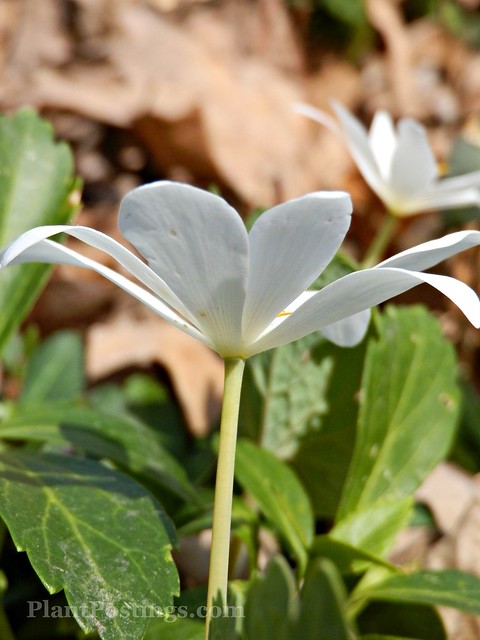
The blooms open during the day, and close up at night.
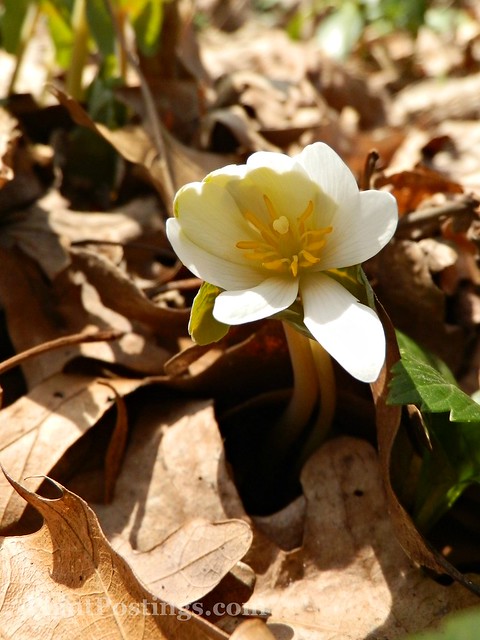
The name Bloodroot comes from the red color of the sap in its stems and roots. I haven't wanted to pull mine up, because I have so few, but here's a link to a photo of the roots from the USDA Forest Service. The plant was used by American Indians for many medicinal purposes, and for dye and war paint, according to the Lady Bird Johnson Wildlife Center.
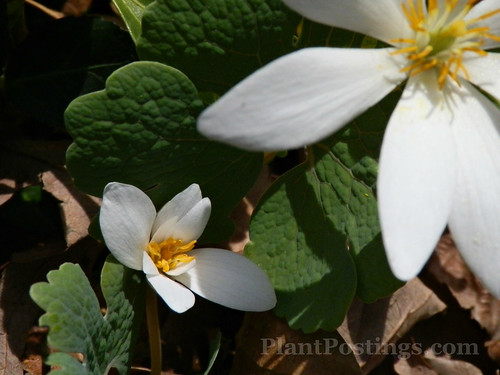
Bloodroot is native through about two-thirds of North America--starting in the north from Manitoba and down through Texas in the south, and eastward through most states and provinces. It likes moist, wet soil; shade or part shade; and a healthy layer of leaf mulch.
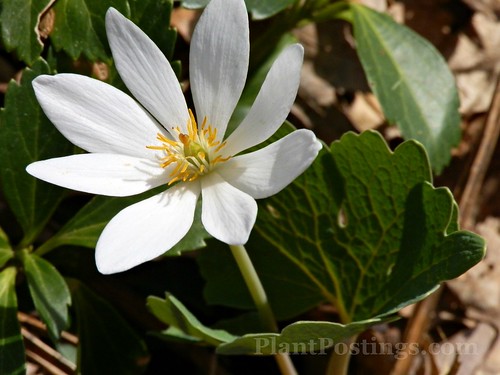
I found out recently that the best way to propagate it is from its seeds, planted immediately in the soil before they have a chance to dry out. The seeds ripen about four weeks after flowering and are ready at that point to be harvested and planted.
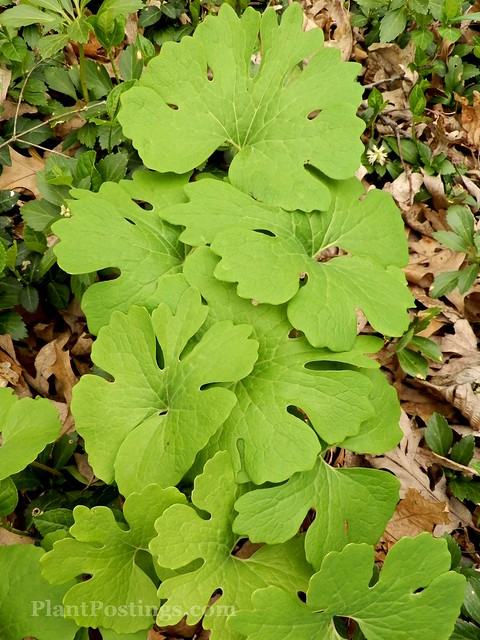
I'm planning to sow some Bloodroot seeds this spring. I noticed a large, healthy patch of it last year that I hadn't noticed before, so that's a good sign.

Bloodroot is definitely one of my favorite plants, and I'm learning more about it every year. My friend, Karin at Southern Meadows, in Georgia, has Bloodroot blooming in her garden now, so visit her to learn more about this beautiful plant.
I'm linking this post to Gail's Wildflower Wednesday. Head on over to her blog, Clay and Limestone, to learn about favorite wildflowers from around the world.
Wonderful post Beth! I am in love with your photos of this gorgeous bloom! Let me know how you do propagating it from seed. I may have to try that too.
ReplyDeleteP.S. Thanks for the link up! xx
Thanks, Karin. There's something intriguing and comforting (to me, at least) about a plant that grows equally well in a range of climates. Although I guess our woodland gardens are probably similar except that mine is delayed a bit. Our posts are complimentary. ;-)
DeleteHi Beth, what a wonderful post about a lovely plant! I haven't heard about Bloodroot prior to your post and I am happy to be introduced to it. I have to research if it is growing in California, too. I really l like the shape of the leaves of this plant and, of course, since white is my favorite color, I adore the delicate white blooms. Great photos, by the way! Happy spring!
ReplyDeleteChristina
Yes, I agree about the foliage. It does stick around a bit, but fades over the summer. The blooms are very short-lived, though. Some years they only seem to last about a day. Thanks! Happy spring to you, too!
DeleteFascinating growth habit on the bloodroot. I especially like the foliage and the pretty little flower is a bonus in the spring garden. I'll look for this one in my area since it seems to be widely distributed.
ReplyDeleteApparently, it's found (and native) in parts of Texas. I would think you might see it on a hike through the woods right about now. Enjoy!
DeleteThat's a very nice looking woodlander - a new one on me Beth. Even better, just looked it up on my local nursery's website and they do in fact stock it. Next time I'm in I'll ask their advice on how well it does over here.
ReplyDeleteA big thank you for adding yet another plant to my ever increasing wish list ;)
I know what you mean about the "wish list." Mine is quite large, as well. Woodland gardens (and woodland wild areas) are so fascinating!
DeleteLovely . . . inspires me for what will be happening very soon, I hope!
ReplyDeleteThanks, Lynne. Yes, one does need hope of course. ;-) This is about the time of year when I decide to avoid posting anymore snow photos. Sometimes I break my pledge, but only if a scene is worth sharing. Our snow right now is nearly gone and very unsightly.
DeleteThe blossoms are so pristinely beautiful, and isn't it true that fleeting beauty speaks to us with an irresistible whisper?
ReplyDeleteGood point, Ricki. I think that's part of Bloodroot's appeal. It's a mysterious little beauty. Ephemerals, in general, are fascinating!
DeleteI like the deeply divided leaves. Might it be related to anemone?
ReplyDeleteI wasn't sure, so I looked it up. They're in the same order, Ranunculales, but different families. I've seen them in the same woodland habitats, though. Both beautiful spring wildflowers!
DeleteShow us the blood root! It's specific epithet sanquinaria isn't for nothing.
ReplyDeleteGood point! I haven't wanted to pull mine up because I have so few, and I found them growing wild here in the woods. But I added a link for people to see the roots. Thanks for urging me to go that step further. :)
DeleteI love it and I always forget that I have and it is a wonderful surprise when it pops up. Such a delicate flower. Great photos.
ReplyDeleteThanks, Chloris. I didn't even realize we had it here until a few years ago. Our back woods are full of spring ephemerals, and it seems I find a new one every few years. Hunting for spring ephemerals on a hike is so much fun!
DeleteA very pretty plant Beth. Wish it was blooming now, heck...anything blooming would do. LOL
ReplyDeleteYes, I agree, Donna. I'm expecting to find a few things emerging on the weekend when the weather warms. I hope we're done with the really cold stuff. 40s aren't so bad this time of year, but 20s--enough!!
DeleteOne of my very favorite wildflowers! Can't wait to see them again!
ReplyDeleteAren't they great?! I'm kind of surprised that I haven't included them as a "plant of the month" until now. I guess last spring was the first time I was able to capture a few decent photos because they fade so fast!
DeleteKathy Purdy sent me a couple of doubles two years ago. I think I must have missed their blooms last year, so I'll be more diligent about seeing them this year. I certainly hope I didn't lose them and that's why I missed seeing them! I planted them near my singles so they wouldn't get lost in the mix.
DeleteLucky you, Kylee, to have both!
DeleteA lovely looking woodland plant. I tried it once in my garden with no result. Thank you for all your interesting information and the beautiful pictures.
ReplyDeleteI have to admit I didn't plant it here, it grows wild in the wooded part of my garden. It seems to like the carpet of Oak leaves that mulch it during the winter. Thank you for your kind comments.
DeleteAt the first time I think that's a white magnolia. I have never seen this flower before. Thanks for sharing.
ReplyDeleteOh, I can see what you mean--especially when the flower is closed up a bit. You're welcome. Thanks for stopping by!
DeleteI enjoyed learning more about this plant. It is one of my favorites. Hope your spring is emerging. :)
ReplyDeleteHi Michelle: I imagine you have some Boodroot plants in your garden, too? Yes, I'm seeing more emerging plants every day, and the ground is thawing! Yay! We will have mild weather (60s) on Sunday, which will help speed things along a little bit. Almost all our snow is melted now.
DeleteI don't have it yet, but it is a lovely flower, both the foliage and the gleaming white blooms.
ReplyDeleteIt would fit in nicely with some of the other native ephemerals you have, Jason. For example, one patch here grows among the Trilliums and the Wild Ginger.
DeleteBeautiful bloom and images. Best hopes for the spring to arrive over there. We had good start for a couple of days and now back to winter again, but with lots of daffodils in parks and gardens. I can't wait to start the season of garden visits!
ReplyDeleteThanks, Lula! It's so interesting how London's temps stay so moderate throughout the year. I understand you didn't even have frost this winter! Meanwhile, we move from -29C (-20F) to 32C (90F) and everything in between almost every year. I'm not sure which I prefer. Best climate, I guess, would be San Diego or Hawaii, but that might get boring. ;-)
DeleteA lovely little plant for a woodland setting – thanks for all the lovely photos and the info! Would possibly be perfect for the bottom of my garden, so I looked it up her and the first one I bumped into for sale was Sanguinaria canadensis ‘Plena’ – it’s double and gorgeous! But I found a few of the single version too for sale so they are obviously OK in the British environment too.
ReplyDeleteI do enjoy the double blooms, too! It looks like that's the kind that Karin has in her Georgia garden. I tried to check and see if Kew Gardens has any Bloodroot in its collection, but I couldn't find out through the website. Kew does have information about the plant, though.
Deletebeautiful shots thanks
ReplyDeleteThank you, Sharon. They are beautiful plants!
DeleteI love Bloodroot too, and your photos are beautiful :) Sorry it's not out yet in your garden! One of mine is up and even has some buds on it...but the others haven't even broken ground yet. Hope yours show up soon!
ReplyDeleteThanks, Jan. It won't be long now. I keep looking for emerging perennials, and each one brings new joy. These guys might be emerging under the leaves, but I don't want to disturb them. And we're supposed to stay sort of cold next week, so the leaf mulch will help. :)
DeleteA stunning plant, and stunning photos...one of my favorite.
ReplyDeleteIt always makes me want to get out the watercolors..such lovely petals and foliage.
Jen
Thanks, Jen. You are much more talented than I am when it comes to painting! Wow, I'd love to see your watercolor painting of Bloodroot!
DeleteTalk about noticing the little things.....this is a plant that I KNOW we must have here in Minnesota, and yet I am unaware of it. But this is the joy of living: you can grow older and still learn new things whether grand or small, and that is when you feel like a child. This is a gorgeous little flower and as soon as our MOUNDS of snow melt (and they have been this week!), I am looking for these ! And I thank you kindly for coming by to visit! May Wisconsin see the sun, as we are hoping to this week! Anita
ReplyDeleteOh yes, Anita, according to several sources, this plant is native as far west as North Dakota, and since our two states are so similar when it comes to wildflowers, I'm sure it would be pretty easy to find these in the woods there--if you look in the right place at the right time. ;-) I so enjoyed your last post, I smiled as I read the words, saw the images, and listened to the music. You're a great director! I hope your snow melts soon. We have a few patches here and there, but not much. I hope we don't have any in April, although it's been known to happen. ;-)
DeleteNo question that pound for pound, this little gem is one of the more stunning and reliable plants in the garden. In a bad oversight, I left my former garden without a piece of it.
ReplyDeleteI agree, Lee. I think part of it for me is how it all of a sudden magically appears, blooms quickly, and then the foliage sticks around for a few weeks. It's one of the more ephemeral ephemerals. :)
DeleteHoly moly are you photos marvelous! Love this beauty and must confess, it's not in my garden...I will fix this error! Happy WW!
ReplyDeleteThank you, Gail! Oh yes, I'm sure it would feel right at home in your wildflower garden. Thanks for hosting!
DeleteBeautiful photos! I planted bloodroot several years ago. I thought it had died, but it finally appeared and flowered last year. So beautiful! I noticed it poking out of the ground the other day. Maybe I will see its bloom tomorrow. It has been very slow to establish here. I hope it will spread!
ReplyDeleteOh, that's wonderful Deb! I hope it spreads for you, too. Enjoy the spring blooms!
DeleteIt seems many of us are either seeing Bloodroot or waiting for it. The snow is still deep on the patch as mine is in a North facing area. Can't wait to see it. Your photos are stunning Beth.
ReplyDeleteThank you, Donna. We still have a few patches of snow, too, Donna. But with the gradual warm-up, we'll soon be seeing more ephemerals. Enjoy the spring thaw.
DeleteYour photos are beautiful Beth! Hopefully there will be more signs of spring soon and your Bloodroot will emerge. It is such a pretty flower with nice foliage as well.
ReplyDeleteThanks, Lee. It has been springy here the past few days, but we're due for some more cold weather next week. Maybe the Bloodroot will emerge after that. It's a welcome sign of spring, for sure!
DeleteHi Beth! Thank you so much for coming to visit my post. It is very kind of you! And yesterday we had some rain and at least 50 degrees, so maybe in a few weeks, I can find some bloodroot in the gardens around here! Have a lovely day, Anita
ReplyDeleteIt's my pleasure, Anita! Our forecast is crazy lately. The weather forecasters keep changing the outlook. We're hovering between late winter and early spring weather. The plants and the animals might be confused, too. ;-)
DeleteLovely information. That bloom looks so shy covered up with her leaf.~~Dee
ReplyDeleteThanks, Dee. It does look demure, doesn't it? Interesting form and a beautiful bloom. :)
DeleteBeautiful. I'll keep my fingers crossed that your seed sprouts and grows a beautiful patch.
ReplyDeleteThanks, Grace! I looked for them in the woods again today, but they're not quite ready to make an appearance. Any day now!
DeleteSuch a lovely spring ephemeral! I don't have this in my garden, but have often thought about it, especially after reading recommendations like yours. Good to know it propagates well from seeds.
ReplyDeleteOurs are growing wild in the woods behind the house. It's fun to hunt back there on warm spring days. I'm still convinced there are more wildflowers on that patch of land yet to discover!
DeleteI had this once but I think my dry shade killed it. It's so pretty I need to try it again in a different spot. Thanks for the reminder!
ReplyDeleteI have a few spots like that--and they got worse during the drought a couple of years ago. I planted some seeds for Pennsylvania Sedge plants, which supposedly do well in dry shade. Crossing my fingers...
Delete